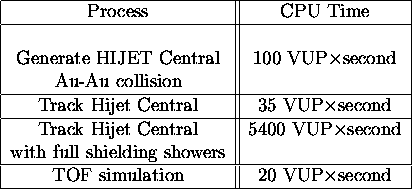Since it is impossible to completely simulate running the apparatus at the
desired level of sensitivity (i.e. generate and completely track ![]() to
to ![]() events) we have concentrated on simulating likely background processes.
events) we have concentrated on simulating likely background processes.
Various parts of the simulation are separately generated and the results
stored in libraries. Information from the libraries is then combined to make
complete events of the type needed to study a particular feature of the
experiment. To illustrate the limitations of computing power,
Table ![]() lists the computing time required for some of the steps
described below.
lists the computing time required for some of the steps
described below.

Table: Typical computing time required for various Monte Carlo steps (1
VUP-second corresponds to 1 CPU second on a Vax 11/780).
Figure ![]() shows the relationship of the various simulations used.
shows the relationship of the various simulations used.
Figure: Chart of steps used in Monte Carlo Simulations.
The simulations were used for two different areas of study. First, we calculate the acceptance of the apparatus for processes of interest and the efficiency for finding tracks of interest in the presence of the rest of the interaction products, including all secondaries, tertiaries, etc. from decays and interactions in the detectors, collimators, magnet pole tips and other surrounding material. Second, we investigate the level at which various background processes can fake an interesting high mass state. Several paths are used to achieve the desired results.
For general studies of the detector performance, we used two event generators. The package HIJET was used to generate Au-Au collisions at 11.71 GeV/nucleon. A separate single particle generator, described below, was used to generate various specific states of interest. The particle types and four-vectors for each event were stored in event libraries.
The event libraries were then processed by the CERN package GEANT. GEANT was used for several different types of processing. First, events could have all tracks traced through the detectors with all secondary processes (decays, interactions, etc.) involving detectors and surrounding air included. In this mode, interactions in the magnet iron, collimators and shielding are not simulated. Tracks entering these materials are lost. The detector hits were stored in ``hit banks,'' and grouped together and stored in event hit libraries. Both HIJET (central collision) events and single particle events were processed in this way.
Another library was formed using HIJET events as above, except that tracks entering the the collimators or pole tips were followed through the full shower process. In this library, only hits due to tracks from interactions in the shielding were kept. This ''shielding hit'' library was generated separately because tracing showers takes a large amount of computer time, so far fewer events of this type could be simulated.
Libraries were also made in which only events were used if a secondary interaction occurred in a specified detector or in the vacuum window and a charged particle from this interaction traversed the rest of the apparatus. Only the hits from the interaction product traversing the rest of the apparatus were saved in the library. This library is used to construct events with enhanced background.
Finally, hit banks from the various libraries were merged to form the desired type of event. For example, to fully simulate a Au-Au collision in which a charge +1, mass 12 exotic was produced, the hit banks for an event from the central collision library, the hit banks from the shielding hits library and the hit banks from the appropriate single particle library are merged. The resulting event is then stored again in another library.
At this point the processing of the Monte Carlo data was separated into two independent paths - one for the tracking system and one for the calorimeter. This reflects the assumption that the efficiencies and background rejection of these detector systems are independent and can be calculated separately.
Two post processors for the GEANT output were used to complete the detector simulation. The program CALSIM was used to make libraries of showers in the calorimeter which were then matched with the impact information from GEANT to form showers in the calorimeter. For the hodoscopes, the energy loss in the hodoscope counters from GEANT (the energy deposition, its position and time for each hit in a counter) was used to simulate the pulse at each phototube and derive a time and pulse height signal. Charged particle hits in the straw tubes were digitized with the appropriate granularity.
Finally, analysis programs were used to analyze the data from the calorimeter or tracking system and the results used to calculate efficiencies or background rejections. Details of the simulations and analysis are given below.